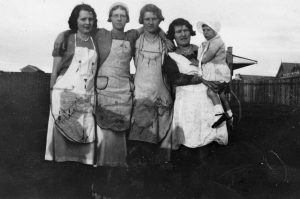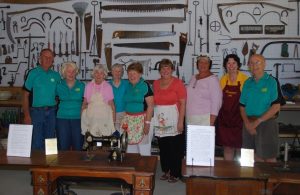by Judith Lewis
“Slipping on Mother’s apron is like getting a big hug from her.” – Joyce Smith
The word “apron” comes from the old French word for napkin or small tablecloth, “naperon”. The dictionary describes the apron as “a garment worn in front of the body to protect clothes”.
In medieval times seedsowers wore a white-coloured apron to carry seeds into the field for sowing. Blacksmiths wore a leather apron to protect their bodies and clothes.
For centuries women stayed home to take care of families and ensure that the home was in a presentable and comfortable state. A memento of this time is “the apron”. This simple piece of scrap material tied around the waist or neck has covered a multitude of sins and been a lifesaver in more ways than one.
Over the times the apron has been used not only to protect clothes from spraying food during cooking or baking but also as a potholder to protect work surfaces from being scorched by hot pans or as a duster for a quick spot of spring cleaning before answering the door to unexpected guests. Housewives and farmers’ wives used their aprons to carry eggs and fresh vegetables and shy children would often spend time hiding behind their mothers’ aprons.
Apron styles continued to unfold in the 19th Century. The all-over apron was required for women who wanted to work whilst wearing their good clothes. It was seamless, with armholes and fitted loosely over the woman’s dress and tied at waist and neck at the back.
In the late 19th Century pinafore aprons were popular, especially for young girls, “Alice in Wonderland” amongst them. In the 1940s the pinafore apron evolved into a cool summer dress worn by girls.
During the depression, when fancy fabrics were in short supply, ladies embellished simple aprons with embroidery. During WWII women joined the war effort by working in factories. Their cotton aprons, which were hand crafted and quite plain, were traded for heavier aprons more suited for their work in the factories.

wearing embroidered aprons. (Photo: Michael Grove)
In the 1940s and 1950s brightly coloured checked aprons became a vivid part of the pattern of home and family life. Gingham became a most popular fabric, often embellished with cross stitch embroidery or trim such as rickrack.
As fabrics for clothing, like polyester and rayon, were introduced, they offered more colours and designs and often required little or no ironing to look fresh and crisp. Clothing then became cheaper to buy and therefore did not need to be so “protected”.
Before the 1960s aprons were viewed as an essential garment for anyone doing housework. In the 1970s men began donning aprons with cute sayings for working with their BBQs and by 1980s aprons had become passé, women were working outside the home and families were eating out more.
Nowadays aprons have come on in leaps and bounds. They are no longer just a practical garment to protect our clothing, but a complimentary fashion statement in their own right. They are now available in fun designs for men, women and children. They are becoming more and more collectable (there are 135,000 entries under “Aprons- history” on the web).
Aprons are a changing way to stay connected with our past.

Graham and Carol Britton, Winsome Phillis, Bev Neal, Heather Smith, Cheryl Ramsden, Carrol Parkes, Rosemary Phillis and Clarrie Neal.
